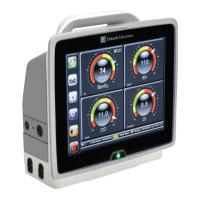HemoSphere Advanced Monitor 12 Advanced Features
158
For parameter derivations, see table C-1 in appendix C, Equations for Calculated Patient Parameters.
12.1.8 Clinical Application
The Hypotension Probability Indicator (HPI) parameter, P(↓BP), can be configured as a key parameter on
the monitoring screen, or it can be displayed only in the Information Bar at the bottom right on the
monitoring screen, as described in Acumen Hypotension Probability Indicator Software Feature on page 150.
When P(↓BP) is displayed in the Information Bar:
• Alarm occurs when P(↓BP) exceeds 85%
• After a second consecutive P(↓BP) value exceeds 85%, High Alert popup appears
• Check patient hemodynamics using the secondary screen and other primary screen parameters in
order to investigate the potential cause of the high probability of hypotension in order to inform a
potential course of action.
When P(↓BP) is configured as a key parameter, P(↓BP) and trend graph appear on the monitoring screen:
• When P(↓BP) is less than or equal to 50%, continue monitoring patient hemodynamics.
• When P(↓BP) exceeds 50% and is less than 86%.
* The trend line and value appear yellow.
* Heighten vigilance with respect to changing patient hemodynamics using the secondary screen
and other primary screen parameters, and monitor both P(↓BP) value and the slope of its trend
line for changes.
• When P(↓BP) exceeds 85%, check patient hemodynamics using the secondary screen and other
primary screen parameters in order to investigate the potential cause of the high probability of
hypotension in order to inform a potential course of action.
• Once mean arterial pressure remains below 65 mmHg for three consecutive readings, indicating the
occurrence of a hypotensive event:
* P(↓BP) displays 100%.
* Check patient hemodynamics using the secondary screen and other primary screen parameters
in order to investigate the potential cause of the hypotension in order to inform a potential
course of action.
12.1.9 Additional Parameters
• Stroke Volume Variation (SVV) – a sensitive dynamic measure of fluid responsiveness, which
predicts whether the preload is increased – by giving more fluid or by reducing the venous
unstressed volume via compensatory control mechanisms or drugs – the heart will respond with an
increase in stroke volume [1]. Low values of SVV are an indicator that a patient is not fluid
responsive; high values are an indicator that a patient is fluid responsive; and there is a gray zone in
between [6].
• Maximal slope of the arterial pressure upstroke (dP/dt) – a sensitive measure of changes in the
contractility of the left ventricle (LV) [1, 2]. The arterial pressure dP/dt (by nature of its compu-
tation during outflow) will have absolute values lower than the isovolumic LV pressure dP/dt-max,
but their changes correlate strongly [1, 2].
Status = Released Printed Date: 2018-01-16 Released Date: 2017-09-14

